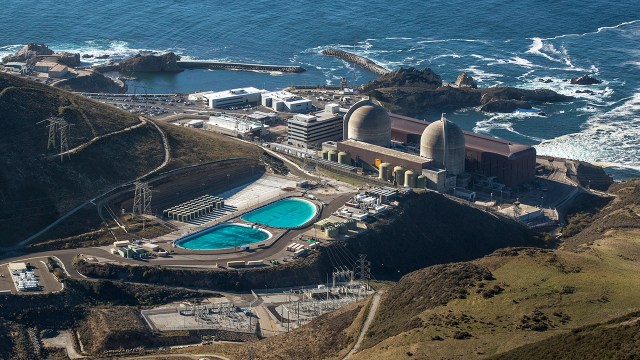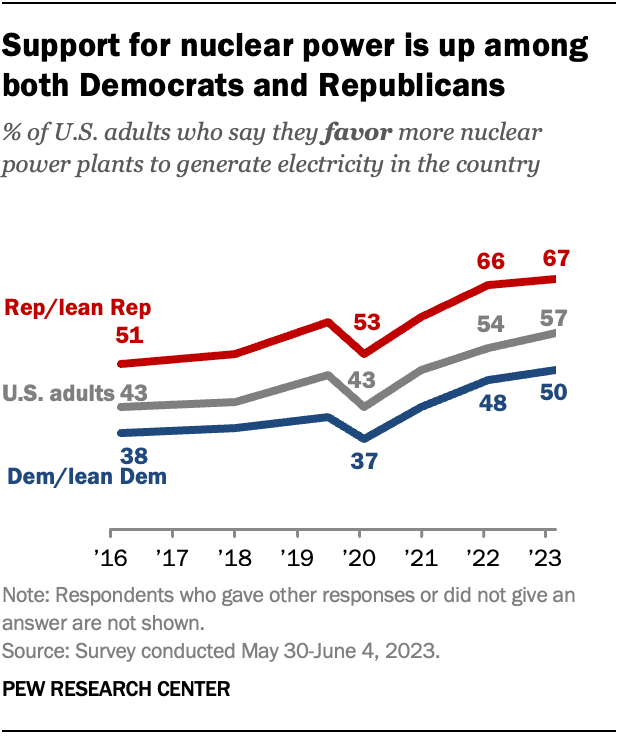
As the first new U.S. nuclear power reactor since 2016 begins operations, more Americans now say they favor expanding nuclear power in the United States than a few years ago, according to a recent Pew Research Center survey.
To measure public attitudes in the United States toward the use of nuclear power, we analyzed data from a survey of 10,329 U.S. adults conducted from May 30 to June 4, 2023. Everyone who took part in the survey is a member of the Pew Research Center’s American Trends Panel (ATP), an online survey panel that is recruited through national, random sampling of residential addresses. This way, nearly all U.S. adults have a chance of selection. The survey is weighted to be representative of the U.S. adult population by gender, race, ethnicity, partisan affiliation, education and other categories. Read more about the ATP’s methodology. Here are the questions used for the analysis, along with responses, and its methodology.
This post also incorporates findings from a Center survey of 10,701 U.S. adults conducted March 13-19, 2023. Here are the questions used in that survey, along with responses, and its methodology.
We tracked the number of U.S. nuclear power reactors over time by analyzing data from the International Atomic Energy Agency’s (IAEA) Power Reactor Information System. The IAEA classifies a reactor as “operational” from the date of its first electrical grid connection to the date of its permanent shutdown. Reactors that face temporary outages are still categorized as operational. Annual totals exclude reactors that closed that year.
A majority of Americans (57%) say they favor more nuclear power plants to generate electricity in the country, up from 43% who said this in 2020.

Americans are still far more likely to say they favor more solar power (82%) and wind power (75%) than nuclear power. All three energy sources emit no carbon.
Advocates for nuclear power argue it could play a crucial role in reducing carbon emissions from electricity generation. Critics highlight the high cost of nuclear power plant projects and the complexities of handling radioactive waste.
Support for nuclear power has increased among both parties since 2020. Half of Democrats and Democratic-leaning independents now say they favor expanding nuclear power, an increase from 37% in 2020. And two-thirds of Republicans and Republican leaners now favor more nuclear power, up 14 percentage points since 2020, when 53% said they support more nuclear power.

When asked about the federal government’s role, 41% of Americans say it should encourage the production of nuclear power. Some 22% think the federal government should discourage the production of nuclear power, and 36% think it should neither encourage nor discourage it. The share of Americans who think the federal government should encourage nuclear power production is up 6 points from last year.
Still, a far larger share of Americans think the federal government should encourage the production of wind and solar power (66%).
Gender, partisan differences in views of nuclear power
Attitudes on nuclear power production have long differed by gender and party affiliation.
Men are about twice as likely as women to say the federal government should encourage the production of nuclear power (54% vs. 28%). Similarly, men are far more likely than women to favor more nuclear power plants to generate electricity (71% vs. 44%).
Views differ by gender globally, too, according to a Center survey conducted from fall 2019 to spring 2020. In 18 of the 20 survey publics, men were more likely than women to favor using more nuclear power as a source of domestic energy.
In the U.S., Republicans are more likely than Democrats to favor more nuclear power and to say the federal government should encourage its production.

Two-thirds of Republicans say they favor more nuclear power plants to generate electricity, compared with half of Democrats.
Republicans have supported nuclear power expansion in greater shares than Democrats each time this question has been asked since 2016.
The 17-point partisan difference on nuclear power is smaller than those for other energy sources, including fossil fuel sources such as offshore oil and gas drilling (48 points) and coal mining (47 points).
A look at U.S. nuclear power reactors

The U.S. currently has 93 nuclear power reactors, plus one that’s under construction in Georgia. These reactors collectively generated 18.2% of all U.S. electricity in 2022, according to the U.S. Energy Information Administration.
Half (47) of the United States’ nuclear power reactors are in the South, while about a quarter (22) are in the Midwest. There are 18 reactors in the Northeast and six in the West, according to data from the International Atomic Energy Agency (IAEA).
The number of U.S. reactors has steadily fallen since peaking at 111 in 1990. Nine Mile Point-1, located in Scriba, New York, is the oldest U.S. nuclear power reactor still in operation. It was first connected to the power grid in November 1969. Most of the 93 current reactors began operations in the 1970s (41 reactors) or 1980s (44), according to data from the IAEA. (The IAEA classifies reactors as “operational” from their first electrical grid connection to their date of permanent shutdown.)
One of the many reasons nuclear power projects have dwindled in recent decades may be perceived dangers following nuclear accidents in the U.S. and abroad. For example, the 2011 Fukushima Daiichi accident led the Japanese government to greatly decrease its reliance on nuclear power and prompted other countries to rethink their nuclear energy plans. More recently, Russian military attacks in Ukraine have raised fears of nuclear power plant accidents in the area.
Note: Here are the questions used for the analysis, along with responses, and its methodology. This is an update of a post first published March 23, 2022.




